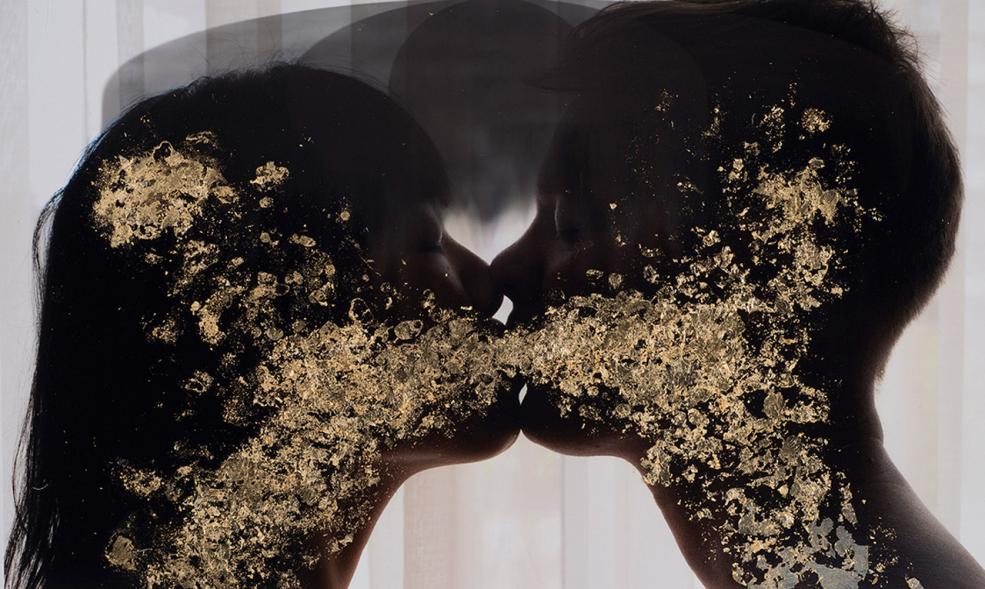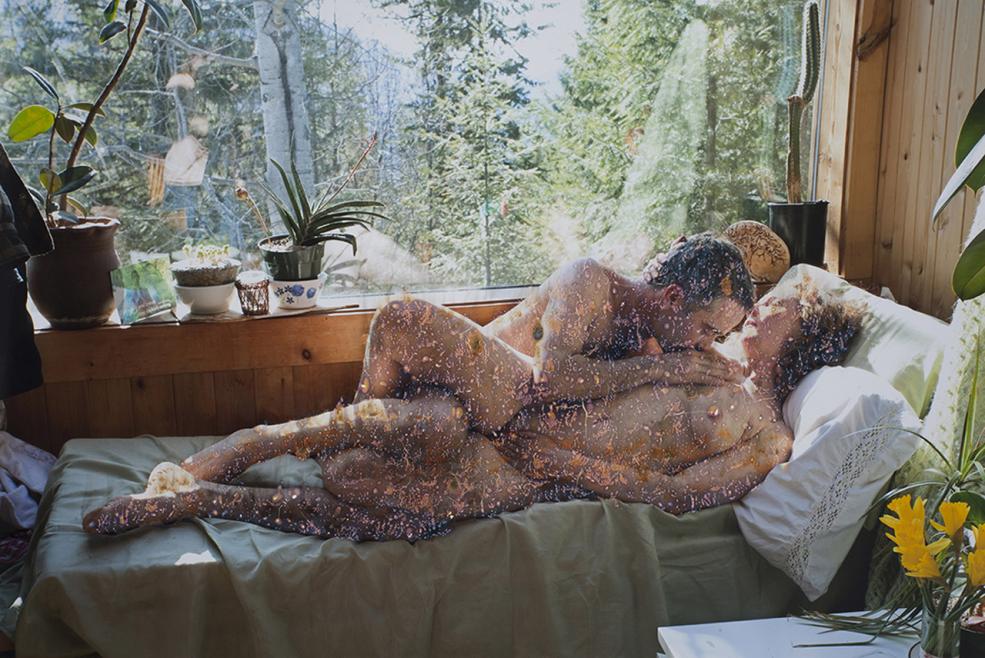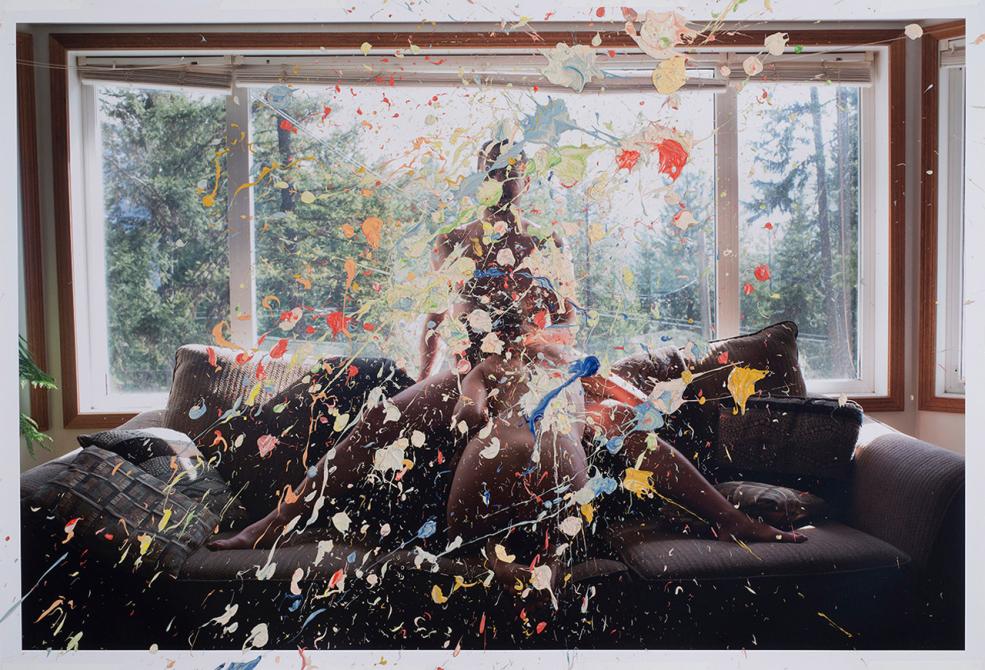Carlos Fonts: You used to be involved in reforesting in Northern Canada. What was that experience like?
Sarah Anne Johnson: It was incredible! So much fun and such hard work. I’m glad I did it, and I’m glad I never have to do it again. We had a group of fifty to sixty tree planters, all in their twenties, living in tents in the middle of nowhere for the summer. It’s really grueling work. You got paid by each sapling you planted and it was, back then anyway, nine to ten cents per tree. You could make a lot of money or hardly any depending on how hard you pushed yourself. Most people were trying to make enough money to get through another school year, so getting cash was a serious issue. You had to push yourself every day, even if you were physically and mentally exhausted or in pain. You had to push on. You were also up against Mother Nature. It was almost never a perfect day to be planting. It would be too hot (sometimes up to 100° F), or too cold (freezing rain with crazy winds). The bugs would be out of control: mosquitos, black flies, deer flies, and horse flies; or the terrain would be too rug- ged; or the truck would break down; or you’d have a two hour walk to get to and from the land you were working. It was so hard! But also so much fun! We drank a lot, danced, sang, had amazing parties with amazing conversations, rode helicopters, witnessed the northern lights too many times to count, gazed at the sunsets, howled at the moon, and skinny-dipped in untapped lakes and rivers.
What is it about nature and the environment that inspires your photography?
My experiences in the great outdoors have changed me more than anything else. Tree planting was a big one. I discovered a whole new part of myself. It gave me a confidence that I would not have otherwise. I also worked construction on a beach in the Bahamas and hiked the Camino de Santiago in Spain. The hike was incredible: 500 miles long and a great test of endurance, both physically and emotionally.
What was it like shooting for Arctic Wonderland? How rugged was the experience?
I was part of an artist residency called The Arctic Circle, which is now doing the trip every year. I was on the program’s maiden voyage. The group met up in Longyearbyen, Norway. We then sailed around the area in a 100 year old, two mast schooner for two weeks. There were around twelve of us, plus four crewmen. It was tight on the ship, but everyone was lovely and interesting. The food was great and the sights were spectacular. It wasn’t very rugged. We would go to shore twice a day to hike an island or see a glacier. It was cold, damn cold, but not much worse than a winter in Winnipeg, where I’m from.
The arctic was breathtaking. I was awe struck. It was so foreign, so unlike anything I have ever seen. I remember thinking that I would probably have the same reaction to landing on Mars. That all made the picture-taking very difficult. Literally, it felt like you could not take a bad shot. It was picture perfect everywhere, but when I came home from the trip I felt very dis- appointed with the photographs. All they did was show what the place looked like. They showed nothing personal, which I think is necessary to make interesting and unique art.
It took about 3 months after the voyage before I realized I could add in the imagery that was missing. I could paint, scratch, screen print, and photoshop in all my concerns and hopes for that beautiful, delicate place.

In terms of setting, Wonderlust is a far cry from Arctic Wonderland. What inspired you to move from the vast, chilly spaces of the Arctic to the warm, intimate spaces of stranger’s homes?
Being in that white, frigid space cramped up on that tiny boat with a group of people bundled head to toe in snowsuits was, psychologically, a weird experience. And then spending a year making work about a possible post-apocalyptic future was really quite depressing. I guess I needed to thaw out and warm up a bit.
Also, The Arctic Wonderland series did really well. Many galleries wanted to show it, it sold really well, and it got a ton of great press. It was very easy to like. Maybe too easy. So I needed to shake it up and make work about a riskier subject. And lastly, I did it for personal reasons. I arrived at a time in my life, possibly triggered by the Arctic, when I started to ponder my own issues of intimacy. We all have them. This pondering became a greater interest, which I began to research more seriously. I was reading some psychology, erotica, and art theory. I was looking at tons of art, trying to find something that spoke to me, and nothing really did. The closest I found was the work by Laura Letinsky and Larry Glawson; both, oddly enough, from Winnipeg. At that point, I had so many images floating around in my mind that I was so excited and curious to create that I had to start making work about it. I tried to talk myself out of it at first, because I thought the ‘art world’ wouldn’t approve of the change in subject matter, especially after the success of Arctic Wonderland. It’s so ridiculous the arguments I have in my head sometimes! The artist always calls the shots.
How did the idea of Wonderlust evolve and progress into a photography project?
Once I decided to make work about it, I put the word out to friends and colleagues that I was looking for people, couples especially, to allow me to take photos of them nude. It was slow going at first. So much so that I had to travel around a bit to get the photo shoots. I knew from the beginning that I wanted to intervene with the surface of the print, but found when I tried to pose the couples too specifically, the end result was too forced. What I ended up doing was going to the photo shoot with no expectations and letting the couple lead the experience. Sometimes they were bold and wanted to put on a show and other times they were shy and I directed them. Some couples had intercourse and others cuddled. I would try to get the best photos I could in the moment and worry about what to add in later. Then I would print the best ones and hang them in the studio. Sometimes I knew right away what to add in. Others took longer to figure out. It was like a really challenging puzzle I had to figure out, and it was different with every image because each couple was so different and their spaces so different. This work is really more about me than it is them, so I had to find moments in the pictures that matched something of myself that I was trying to express.

Was Wonderlust the type of project you’ve always wanted to do, or was it a recently adopted intrigue?
Recent. Three years ago I never would have guessed I’d be making this work.
Do you feel that sex and intimacy are directly related? Did your perspective on sex and intimacy change after you finished shooting Wonderlust?
Yes, for me it is related. My perspective has probably changed subtly, or is in the process of changing still, but I don’t know how just yet.
What does intimacy mean to you? And do you think you’ve accurately conveyed your perspective in these photographs?
I’m in a long term relationship, so for me intimacy is about finding ways of reconnecting with my partner and about being patient during the periods when we don’t. For this project, because intimacy encompasses so many different elements, I focused on sexual intimacy – when we connect, when we don’t, and why. I was interested in revealing the differences between what those issues look like and what they feel like, the interior versus the exterior. The straight photograph on their own, depicts what it looks like, then by adding onto the surface I can reveal the psychology beneath. I used different mediums and types of imagery to illustrate how complex and layered these issues are. I have conveyed these ideas to the best of my abilities to date. Although I feel like I have only begun to scratch the surface, and I’m eager to explore it further.
What response do you hope to provoke in the viewers with these photographs?
I was hoping that people would have all kinds of different reactions to images in the exhibition. I was hoping that some images would make people feel uncomfortable or awkward. Maybe a bit of longing. Other images might inspire and excite. I was hoping, and maybe this is unrealistic, that de- pending on where the viewer is romantically in their own life, it will define how they personally interpret and absorb the work, and that these views would change as the viewer changes. I was striving to make work that could grow with a person. To make something that can mean different things at different times in someone’s life.

What about your personality contributed to the success of Wonderlust?
I’m respectful and a bit of a dork. I think that helps to put people at ease.
What was it like sharing a space with partners engaging in such private moments with one another, and then photographing it? How much direction did you give, if any?
It was fascinating! If you ever have the opportunity I highly recommend it. It was such a privilege. I have so much respect for everyone who ‘posed’ for me. It was also awkward and uncomfortable at times; especially in the beginning when I wasn’t certain what I wanted photographically, but I soon figured out what I wanted and how to be more comfortable during the shoot, and in doing so, I figured out how to make the couples feel more comfortable with me. Some couples wanted to put on a show for me and wouldn’t take direction if I tried. Others were a bit shy but interested in trying something new. At times I was a fly on the wall, and during others I would loosely direct.
When did you start making photographs? And when did you start manipulating physical prints?
I started taking pictures in undergrad and didn’t love it, but it came to me most naturally out of all the art forms I tried. I went on to do my masters in a pretty strict photography program. During my masters, I painted and scratched on some images but never showed anyone. It seemed too silly. It wasn’t until around 2009 that I started painting on images. I was using found family photos and wanted to illustrate something psychological in them and there was no other way.
What’s your personal fantasy?
Respecting and protecting Mother Earth, the end of poverty and world peace. Also, a three way with my boyfriend and some masked hot Russian. I like the accent.


